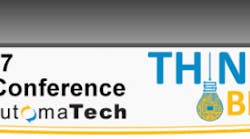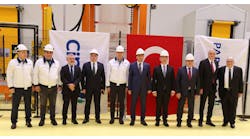Industrial companies are feeling pressure to explore new ways of managing the complexities of their automation infrastructure while also increasing productivity. Those implementing Industrial Internet of Things (IIoT) technologies are realizing its potential for doing just that—driving new efficiencies and productivity gains. As this automation infrastructure becomes more connected, however, even momentary periods of unplanned downtime can disrupt business continuity in a major way.
[sidebar id =1]At AutomaTech’s ThinkBIG 2017 User Conference in Cape Cod, Massachusetts, Jason Andersen, vice president, business line management at Stratus Technologies, detailed successful implementations of Stratus’ always-on infrastructure for IIoT—technologies designed to prevent this unplanned downtime industrial companies worry about as they adopt IIoT advancements. This included the Stratus ftServer fault-tolerant system and VMware vSphere 6.0, as well as monitoring and OPC integration—pieces intended to bring the best of both worlds to an organization’s IT and OT teams. OT benefits from an intuitive dashboard and application health status, while IT benefits from a platform that can be integrated into management, security and other processes.
Getting infrastructure right—walk before you run
One Stratus customer that Andersen referenced was a U.S. cooperative dairy foods company with thousands of members supplying more than 40 processing facilities. Its key challenges were improving the efficiency of its capital investments as it grew, standardizing operations across a diverse set of products and understanding its supply chain from farm to refrigerator. Stratus’ approach involved modernizing plant assets and infrastructure in the first three years, then deploying analytics across their facilities for real-time decision-making and, ultimately, activating the more intelligent supply chain the company was looking for.
“The important piece of the whole thing is getting your infrastructure right,” explained Andersen. “Data is what makes IIoT a long-term business imperative. To get to the long-term, you have to start with fixing the site and then getting benefits across the supply chain. Then you can start to realize the idea of bringing it all the way across. If I can put a tag on the cow and know where the milk comes from, then I can follow it all the way to the refrigerator.”
As you start to automate more, the data changes things, noted Andersen. “Now, I can predictively do things,” he said. “Informed operators can react. Insightful operators can plan and adjust because of analytics. Machines get smarter. Driverless cars and autonomous factories don’t need people any more for any process.”
Keys to growing your data capabilities
As an operation scales to grow its use of data in the IIoT, the protection and management of this data in real-time must also become a priority, explained Andersen. He mentioned this hinges on four things in particular and that finding all four happening in concert today is still pretty much nonexistent.
1. reliable infrastructure
2. secure connectivity: “You don’t want the data tampered with,” warned Andersen.
3. high-performing applications: “Why do you want to upgrade SCADA? How the applications perform can become a predictive metric,” said Andersen.
4. predictive serviceability: “How do you service it?” asked Andersen. “If something breaks, can you remotely manage and service the technology, and can you predict a failure before it happens?”
Preparing for the future of the network edge
In an always-on IIoT solution, the system should be actively communicating with the vendor, explained Andersen. “We’re moving from servers to the next generation of edge infrastructure—a unified edge that involves connecting existing product and service capabilities,” he said. “It will be a unified stack of IIoT apps and hardware that further consolidates IT infrastructure into a comprehensive predictive service model.”
Stratus’ Smart Connected Hub vision will massively simplify edge solutions, predicted Andersen. “It will reduce costs and minimize IT burden; it will enable OT to lead IIoT transformation; it will eliminate production downtime; and it will monitor and manage itself with outside help,” he explained. “The Smart Connected Hub is a physical device that will support virtualization. It will be a next-generation Stratus server. At the end of the day, you’re not going to be able to put everything in the cloud, so how do we replicate that?”





